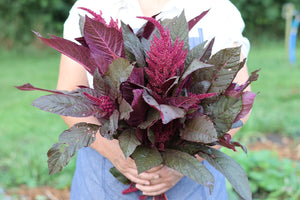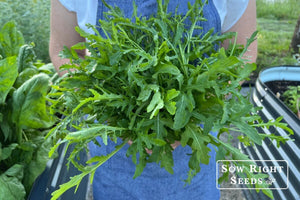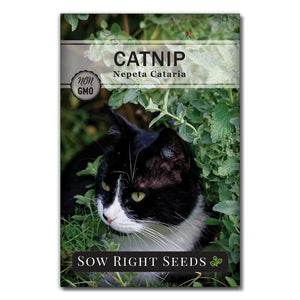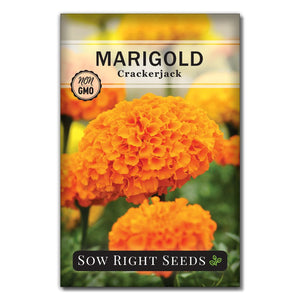How to Use Neem Oil on Plants for Successful Pest Control
PestsThis summer, it seemed like the bugs were out in greater abundance! When aphids were about to take over the garden, we decided it was time to take control. We didn’t want to apply toxic chemicals to our vegetables, so we turned to neem oil. We learned a few things in the process and wanted to share our tips with our gardening friends. At Sow Right Seeds, we love helping gardeners be successful and enjoy their harvest. So, along with our growing guides, we’re sharing our tips on using neem oil for pest and disease control in your garden. We’ll explain what neem oil is and why we use it in our garden.

What is Neem Oil?
Neem oil is a natural, plant-based oil derived from the seeds of the neem tree (Azadirachta indica). Native to India and other parts of Southeast Asia, the neem tree has been revered for its medicinal and pesticidal properties for centuries. The oil is extracted through a process of cold pressing, which ensures that the beneficial compounds in the neem seeds are preserved.
Neem oil has gained popularity in recent years as a safe and eco-friendly alternative to chemical pesticides and fungicides in gardening. Its active ingredients, particularly azadirachtin, are known for their potent pest-repelling and antifungal properties.
Neem oil is rich in natural compounds, such as azadirachtin, nimbin, and salannin, that make up its potent insecticidal and fungicidal properties.
What Does Neem Oil Do?
Neem oil works as an insect repellent, pesticide, and fungicide. It’s considered an important organic way to control plant pests and diseases.
1. Pest Control: Neem oil is a natural insect repellent and pesticide. It disrupts the feeding and reproductive cycles of many common garden pests, including aphids, mealybugs, spider mites, whiteflies, and caterpillars.
2. Fungicide: Neem oil also has antifungal properties, making it effective in preventing and treating various plant diseases, such as powdery mildew, black spot, rust, and leaf spot.
How Does Neem Oil Work?
Neem oil's effectiveness in pest and disease control is attributed to its active compounds, primarily azadirachtin. Here's how it works:
1. Disrupts Pest Feeding and Reproduction: Azadirachtin interferes with the insects' hormonal systems, disrupting their ability to feed and reproduce. This can lead to reduced pest populations in your garden.
2. Antifungal Benefits: Neem oil's antifungal properties are effective against a variety of plant pathogens. It forms a protective barrier on plant surfaces, preventing fungal spores from germinating and infecting your plants.

What Is Neem Oil Used On?
Neem oil can be used on a wide variety of plants, including vegetables, fruits, herbs, ornamentals, and even houseplants. It is a versatile solution for addressing both pest infestations and fungal diseases. Some common uses for neem oil in the garden include:
1. Vegetables and Fruits: Neem oil is particularly useful for protecting edible crops like tomatoes, cucumbers, peppers, and fruit trees from pests and diseases.
2. Flowers and Ornamentals: Using neem oil can help maintain the beauty of your garden by preventing unsightly fungal infections and deterring common garden pests that damage your prized flowers and ornamental plants.
3. Indoor Plants: Neem oil is safe for use on indoor plants, offering a natural way to keep your houseplants healthy and pest-free.
4. Lawns: You can use neem oil to prevent lawn diseases and control pests like grubs and chinch bugs.
How to Use Neem Oil for Garden Pests
Now that you understand what neem oil is and its benefits, we’ll explain how to use it effectively to control garden pests:
1. Prepare the Neem Oil Solution:
- Start by purchasing high-quality neem oil from a reputable supplier.
- Follow the manufacturer's instructions for diluting the neem oil. Typically, a ratio of 1 to 2 tablespoons of neem oil per gallon of water is recommended.
- You will need to keep shaking or stirring the mixture to keep it combined. After all, you’re mixing oil and water. You can also add a few drops of dish soap to help the oil emulsify.
- Neem oil’s effectiveness breaks down within a day, so only mix up as much as you need for each application.
2. Apply the Neem Oil Solution:
- Spot test a leaf first to see if the plant is sensitive to neem oil. Herbs, lettuce, and spinach are more sensitive to sprays.
- Use a handheld or garden sprayer to apply the neem oil solution to both the tops and bottoms of plant leaves.
- Ensure thorough coverage, especially on the parts of the plants most vulnerable to pests.
3. Timing Matters:
- Apply neem oil in the early morning or late evening when the temperature is cooler. This prevents the risk of leaf burn due to sun exposure. It also reduces the chance of interfering with beneficial pollinators.
- Avoid applying neem oil during extreme heat or when rain is expected within a few hours.
4. Repeat as Necessary:
- For ongoing pest control, apply neem oil every 7 to 14 days or as recommended on the product label.
- Continue applications until the pest infestation is under control.
5. Monitor Results:
- Keep an eye on your plants to observe the effectiveness of neem oil in controlling pests. You should see a reduction in pest populations over time.
6. Be Patient:
- Neem oil works gradually, so be patient and persistent in your application. It may take a few weeks to fully control the pest problem. We noticed a significant reduction in aphids with our first neem oil application. But other bugs take multiple applications.
How to Use Neem Oil for Plant Diseases
Neem oil spray can also combat plant diseases such as powdery mildew. It keeps the spores from spreading. To combat plant diseases with neem oil, follow these steps:
1. Prepare the Neem Oil Solution:
- Similar to pest control, dilute neem oil following the manufacturer's instructions.
2. Apply the Neem Oil Solution:
- Use a sprayer to evenly apply the neem oil solution to all parts of the affected plant, including the leaves, stems, and any visible disease symptoms.
- It's important to apply the solution thoroughly, covering both infected areas and the surrounding healthy foliage.
3. Repeat Applications:
- For disease prevention, apply neem oil every 7 to 10 days.
Neem Oil FAQs
Is Neem Oil Toxic to Pets?
Neem oil has to be ingested for it to affect animals. However, getting it in their eyes or nose could give them irritation. Keep pets away while spraying to limit their exposure.
Is Neem Oil safe for bees?
Animals have to eat the oil to be affected. It also breaks down quickly in the sunlight. Apply neem oil in the early morning or late evening to avoid the times when bees and other pollinators are out foraging.
What plants should you not use neem oil on?
While neem oil is safe for plants, some are more sensitive to having oils applied to their leaves. Lettuce, spinach, and some herbs will have leaf wilt when neem oil is used. If you decide the benefits outweigh the risks, apply it in the early morning or late evening to avoid the effects of oil with sunlight on the leaves.
When bugs threaten to overtake your garden, there are many pesticide choices. At Sow Right Seeds, we prefer to use methods that target the destructive bugs without harming the beneficial pollinators. We also don’t want to put chemicals on our food that can be unsafe when we eat them. If disease and pests threaten your garden harvest, try applying neem oil. It’s an eco-friendly pesticide and fungicide that will rescue your plants from attack.
Found this information helpful? Share it with your gardening friends!









Leave a comment